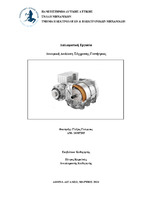| dc.contributor.advisor | Καραϊσάς, Πέτρος | |
| dc.contributor.author | Γλέζος, Γεώργιος | |
| dc.date.accessioned | 2024-03-26T14:59:57Z | |
| dc.date.available | 2024-03-26T14:59:57Z | |
| dc.date.issued | 2024-03-19 | |
| dc.identifier.uri | https://polynoe.lib.uniwa.gr/xmlui/handle/11400/6176 | |
| dc.identifier.uri | http://dx.doi.org/10.26265/polynoe-6012 | |
| dc.description.abstract | Οι σύγχρονες γεννήτριες είναι μία κατηγορία ηλεκτρικών μηχανών εναλλασσομένου ρεύματος. Χαρακτηριστικό τους είναι ότι ο δρομέας τους περιστρέφεται με την σύγχρονη ταχύτητα στην μόνιμη κατάσταση, δηλαδή με την ταχύτητα του στρεφόμενου μαγνητικού πεδίου στο διάκενό τους. Ως γεννήτριες, έχουν το χαρακτηριστικό ότι δέχονται μηχανική ενέργεια στην είσοδο και παράγουν ηλεκτρική ενέργεια στην έξοδο. Χρησιμοποιούνται σε πολλές εφαρμογές, όπου απαιτείται ηλεκτρική ενέργεια, όπως σε σταθμούς παραγωγής ηλεκτρικής ενέργειας και σε κτιριακές και βιομηχανικές εγκαταστάσεις. Τα βασικά τους τυλίγματα είναι το τύλιγμα τυμπάνου στον στάτη-ένα τριφασικό διανεμημένο τύλιγμα-και το τύλιγμα διέγερσης στον δρομέα-ένα συγκεντρωμένο τύλιγμα συνεχούς ρεύματος. Ανάλογα με την κατασκευή του δρομέα τους, διακρίνονται σε κυλινδρικού δρομέα και εκτύπων πόλων. Το ισοδύναμό τους κύκλωμα στην μόνιμη κατάσταση εξαρτάται από το είδος τους αυτό και καθορίζει την μορφή του, αλλά και την μεθοδολογία μελέτης του. Οι παράμετροι του ισοδυνάμου κυκλώματός τους είναι, αφού περιέχουν τυλίγματα, ωμικές αντιστάσεις, αυτεπαγωγές των τυλιγμάτων και αλληλεπαγωγές μεταξύ των τυλιγμάτων. Τα ηλεκτρικά μεγέθη που τις περιγράφουν είναι, μεταξύ άλλων, τάσεις και ρεύματα στο τύλιγμα διέγερσης και στο τύλιγμα τυμπάνου, αλλά και πεπλεγμένες ροές, αφού εκτυλίσονται ηλεκτρομαγνητικά φαινόμενα σε αυτές. Η δυναμική ανάλυσή τους, δηλαδή η ανάλυσή τους στην μεταβατική κατάσταση, είναι περισσότερο εκτενής από αυτήν στην μόνιμη κατάσταση, καθώς περιλαμβάνει κατάστρωση πολλών διαφορικών εξισώσεων, οι οποίες απαιτείται να μετασχηματισθούν, μέσω του μετασχηματισμού Park, σε εξισώσεις με νέες μεταβλητές, σταθερού μέτρου, ώστε να μπορούν να είναι ευχέρως επεξεργάσιμες. Τα μοντέλα, τα οποία μπορούν να εξαχθούν από αυτή την διαδικασία είναι αυτό των ρευμάτων ως μεταβλητών κατάστασης και αυτό των πεπλεγμένων ροών ως μεταβλητών κατάστασης. Στην παρούσα εργασία αξιοποιείται, εν τέλει, το μοντέλο των πεπλεγμένων ροών, το οποίο, με την σειρά του, μετατρέπεται σε ένα μοντέλο ενός ανά μονάδα συστήματος, όπου η περιπλοκότητα των εξισώσεων δεν υπάρχει πλέον και το μοντέλο μπορεί να υλοποιηθεί σε περιβάλλον προσομοίωσης. Το πρόγραμμα προσομοίωσης που χρησιμοποιείται είναι το Simulink του MATLAB. Σε αυτό πραγματοποιούμε 5 διαφορετικές εφαρμογές στο μοντέλο, μεταξύ αυτών μεταβολές στην κινούσα μηχανική ροπή, στην τάση διέγερσης και ένα σενάριο τριφασικού βραχυκυκλώματος στους ακροδέκτες της γεννήτριας. Όλες οι εφαρμογές είναι διαφωτιστικές, καθώς αναδεικνύουν την σχέση μεταξύ των δυναμικών εξισώσεων και των εξισώσεων μόνιμης κατάστασης, αλλά και τις αδυναμίες της γεννήτριας, οι οποίες, χάρη στην προσομοίωση, μπρούν να αποτραπούν σε πραγματικά σενάρια. | el |
| dc.format.extent | 164 | el |
| dc.language.iso | el | el |
| dc.publisher | Πανεπιστήμιο Δυτικής Αττικής | el |
| dc.rights | Αναφορά Δημιουργού - Μη Εμπορική Χρήση - Παρόμοια Διανομή 4.0 Διεθνές | * |
| dc.rights | Attribution-NoDerivatives 4.0 Διεθνές | * |
| dc.rights.uri | http://creativecommons.org/licenses/by-nd/4.0/ | * |
| dc.subject | Ηλεκτρικές μηχανές | el |
| dc.subject | Σύγχρονες γεννήτριες | el |
| dc.subject | Προσομοίωση | el |
| dc.subject | Simulink | el |
| dc.subject | MATLAB | el |
| dc.subject | Γεννήτριες | el |
| dc.title | Δυναμική ανάλυση σύγχρονης γεννήτριας | el |
| dc.title.alternative | Dynamic analysis of a synchronous generator | el |
| dc.type | Διπλωματική εργασία | el |
| dc.contributor.committee | Μαλατέστας, Παντελής | |
| dc.contributor.committee | Συγγερίδου, Ολυμπιάδα | |
| dc.contributor.faculty | Σχολή Μηχανικών | el |
| dc.contributor.department | Τμήμα Ηλεκτρολόγων και Ηλεκτρονικών Μηχανικών | el |
| dc.description.abstracttranslated | Synchronous generators are a category of alternating current electric machines. Their characteristic is that their rotor rotates with the synchronous speed in the steady state, that is, with the speed of the rotating magnetic field in their air-gap. As generators, they have the characteristic of receiving mechanical energy at the input and producing electrical energy at the output. They are used in many applications where electricity is required, such as in power stations and in building and industrial facilities. Their basic windings are the armature winding on the stator-a three-phase distributed winding-and the field winding on the rotor-a concentrated DC winding. Depending on the construction of their rotor, they are divided into cylindrical rotor type and salient-pole type. Their equivalent circuit in the steady state depends on their rotor type and determines its form, but also its study methodology. Their equivalent circuit parameters are, since they contain windings, ohmic resistances, inductances of the windings and mutual inductances between the windings. The electrical quantities that describe them are, among others, voltages and currents in the field winding and the armature winding, but also flux linkages, since electromagnetic phenomena occur in them. Their dynamic analysis, i.e. their analysis in the transient state, is more extensive than that in the steady state, as it involves the construction of many differential equations, which are required to be transformed, through the Park transform, into equations with new variables, of constant value, so that they will be easily editable. The models that can be derived from this process are that of currents as state variables and that of flux linkages as state variables. In the present diploma thesis, the model of flux linkages is finally utilized, which, in turn, is transformed into a model of a per unit system, where the complexity of the equations is no longer present and the model can be implemented in a simulation environment. The simulation program used is MATLAB's Simulink. In it, we perform 5 different applications on the model, including changes in the driving mechanical torque, the excitation voltage and a three-phase short-circuit scenario at the generator’s terminals. All the applications are enlightening as they highlight the relationship between the dynamic and steady state equations, but also the weaknesses of the generator which, thanks to the simulation, can be avoided in real scenarios. | el |


